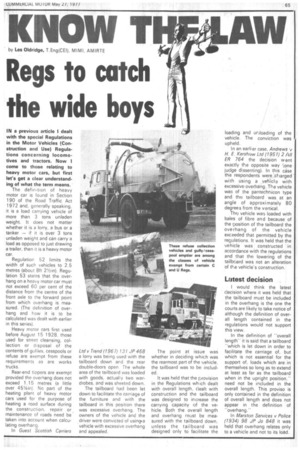Regs to catch the wide boys
Page 67

If you've noticed an error in this article please click here to report it so we can fix it.
IN a previous article I dealt with the special Regulations in the Motor Vehicles (Construction and Use) Regulations concerning locomotives and tractors. Now I come to those relating to heavy motor cars, but first let's get a clear understanding of what the term means. • The definition of heavy motor car is found in Section 190 of the Road Traffic Act 1972 and, generally speaking, it is a load carrying vehicle of more than 3 tons unladen weight. It does not matter whether it is a lorry, a bus or a tanker — if it is over 3 tons unladen weight and can carry a load as opposed to just drawing a trailer, then it is a heavy motor car.
Regulation 52 limits the width of such vehicles to 2.5 metres (about 8ft 2Y2 in). Regulation 53 states that the overhang on a heavy motor car must not exceed 60 per cent of the distance from the centre of the front axle to the forward point from which overhang is measured. (The definition of overhang and how it is to be calculated was dealt with earlier in this series).
Heavy motor cars first used before August 15 1928, those used tor street cleansing, collection or disposal of the contents of gullies, cesspools or refuse are exempt from these requirements as are works trucks.
Rear-end tippers are exempt provided the overhang does not exceed 1.15 metres (a little over 451/4in). No part of the heating plant of heavy motor cars used for the purpose of heating a road surface during the construction, repair or maintenance of roads need be taken into account when calculating overhang.
In Guest Scottish Carriers
Ltd v Trend (1967)131 JP 468 a lorry was being used with the tailboard down and the rear double-doors open. The whole area of the tailboard was loaded with goods, actually two wardrobes, and was sheeted down.
The tailboard had been let down to facilitate the carriage of the furniture and with the tailboard in this position there was excessive overhang. The owners of the vehicle and the driver were convicted of using-a vehicle with excessive overhang and appealed.
The point at issue was whether in deciding which was the rearmost part of the Nre h icle, the tailboard was to be included.
It was held that the provision in the Regulations which dealt with overall length, dealt with construction and the tailboard was designed to increase the carrying capacity of the vehicle. Both the overall length and overhang must be measured with the tailboard down, unless the tailboard was designed only to facilitate the loading and unloading of the vehicle. The conviction was upheld.
In an earlier case, Andrews H. E. Kershaw Ltd (1951) 2/4/I ER 764 the decision went exi3ctly the opposite way one judge dissenting). In this case the respondents were 'charged with Using a vefticle with excessive overhang. The vehicle was of the pantechnicon type and the tailboard was at an angle of approximately 80 degrees from the vertical.
The vehicle wars loaded with bales of fibre and because of the position of the tailboard the overhang of the vehicle exceeded that permitted by the 'regulations. It was held that the vehicle was constructed in iaccordance with the regulations and that the lowering of the tailboard wa.s not an alteration of the vehicie's construction.
Latest decision .
I would think the latest decision where it was held that the tailboard must be included in the overhang is the one the courts are likely to take notice of although the definition of overall length contained in the regulations would not support this view.
In the definition of "overall length" it is said that a tailboard "which is let down in order to facilitate the carriage of, but which is not essential for the support of, loads which are in themselves so long as to extend at least as far as the tailboard when in the upright position," need not be included in the overall length. This proviso is only contained in the definition of overall length and does not appear in the definition of "overhang."
In Marston Services v Police' (1934) 98 JP Jo 848 it was held that overhang relates only to a vehicle and not to its load.












































































































